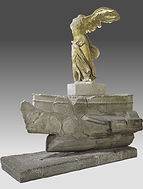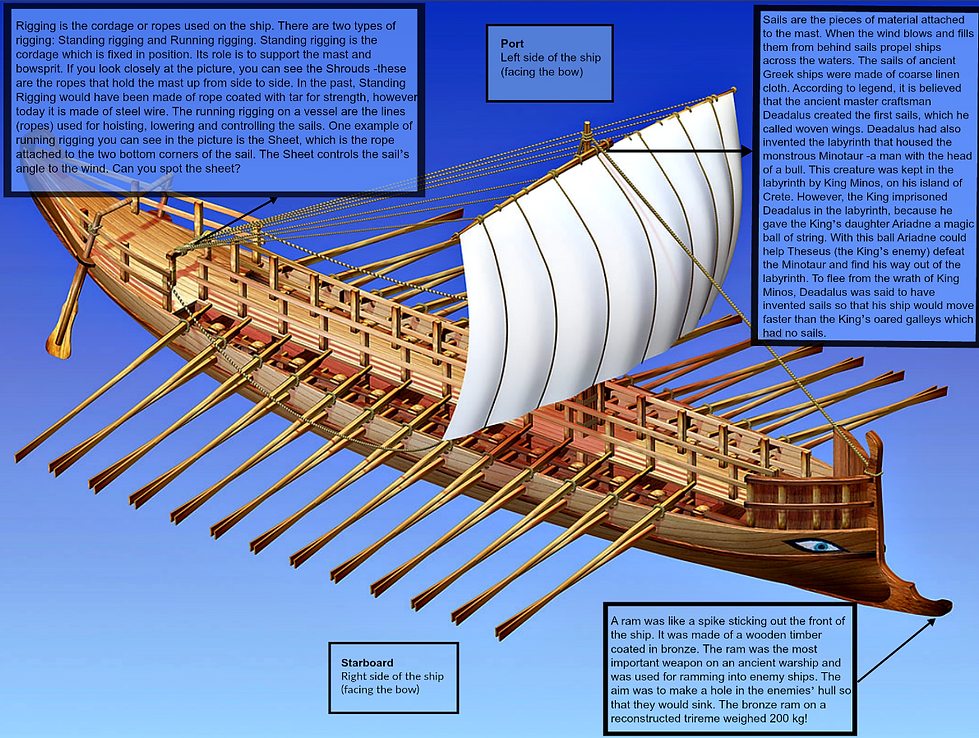SEVEN SEAS
SEAFARING IN ANCIENT GREECE
Greece is a country surrounded by water and the sea has always played an important role in its history. The ancient Greeks were active seafarers seeking opportunities for trade and founding new independent cities at coastal sites across the Mediterranean Sea. By the seventh and sixth centuries BCE, Greek colonies and settlements stretched all the way from western Asia Minor to southern Italy, Sicily, North Africa, and even to the coasts of southern France and Spain. As a powerful naval force in the latter part of the sixth and fifth centuries BCE, Athens exerted its influence over sea trade.
There were many different types of ships during the 5th-4th centuries BCE. Warships, called war galleys, included: pentaconters, biremes, triremes. Smaller boats used for patrolling harbours. The much larger “polyremes” of ancient Carthage, Rome and Egypt were not common in the Greek classical world. The Greeks favoured smaller classes of ships that were highly manoeuvrable and swift, in comparison to larger, heavier ships. Smaller ships also had the benefit of being able to navigate smaller river systems with their shallow keels and shorter hull lengths.
Ships designed for the transportation of goods, people and animals were also widely used. They were often repurposed war galleys with a reduced oar-crew to allow for more storage space.
KNOW THY SHIP
The triakontoros, like the penteconter, belongs to the family of multi-oared ships which were most likely the types of vessels sailed by ancient Greek heroes. Plutarch said, that it was in a triakontoros that the hero Theseus sailed to slay the fearsome minotaur. The ancient historians Thucydides and Herodotus both believed that the triakontoros and the penteconter were the main types of warships and seagoing vessels before the trireme established its dominance.
The triakontoros was a hollow ship without a deck, a curved stern and oblong hull. There were two boarded areas in the bow and stern, and probably a boarded walkway between two rows of sunken benches on which the oarsmen would have sat to row the boat. Beneath the benches there would have to store supplies (water, wine, oil, grain, dried fruit etc.)
TRIAKONTOROS
THE ARGO
The Argo was built by Argus with the help of the goddess Athena. The ship was built from the wood of a tree felled in the magical forest of Dodona. Dodona was a sacred area in Ancient Greece, a region linked with the god Zeus and prophecy. The Oracle of Dodona was considered second only to the Oracle of Delphi in the ancient world. Thus, using oak from the sacred forest imbued the Argo with mystical powers. The ship was said to be able to speak and to offer up prophecies of its own.
There has been much discussion, both in antiquity and more recently, as to the type of ship the Argo would have been. It is said the Argo was a ‘ship to sail the seas’ which may indicate that the Argo was a galley that would have been large enough to traverse the open ocean.
The simplest of the early Greek galleys were monoremes (like the ship above), which only had a single bank of oarsmen along each side of the ship. It is estimated that there were 50 Argonauts sailing the Argo. This tells us that the Argo was likely a penteconter with 50 oars.
SHIP DESIGN AND DECORATION
Although most Triremes were designed alike, there were many areas in which sailors could customise their ships. For example, the name of the ship was placed on both sides of the ship’s bow (front of the ship). Sometimes an image of a god, weapon or animal associated with the name of the ship was painted at the bow instead. This name or image could be carved, painted, or written on a bronze plaque.
In line with this, a shrine was often placed near the back of the ship representing patron deities, gods or other associated symbols. This shrine was seen by sailors as a form of protection from harm and bad

Triremes, affectionately referred to as wooden walls, were pivotal in ensuring the survival and freedom of the Greeks by putting an end to the Persian aspirations for dominance in the battle of Salamis in 480 BCE. Triremes were not only battleships but also a means for sharing Greek culture with the wider world. The increased capabilities of triremes helped secure trade routes allowing Hellenic ideas and goods to be transported to new cultures with ease.
The trireme evolved from the penteconter and the bireme. According to Thucydides the first triremes were made in Corinth. However it was the Athenians who redeveloped the trireme into a ship of power, agility and beauty, which dominated the seas.
TRIREME
luck. For extra protection, sailors also prayed to Poseidon the god of the sea for mercy and calm waters before they embarked on their voyage. Finally, the hull of a ship was often painted with various patterns and designs, the most famous of which are the eyes at the front of a trireme.
As the bow and stern were typically curved, this allowed for further decoration and embellishment. For example, the sternpost could be carved into an animal, usually a goose head or another bird. On merchant or commercial ships this head could be gilded in bronze or potentially even gold.
HAVE A LOOK AT THE IMAGES BELOW TO GET A BETTER IDEA OF THE MAIN ELEMENTS OF AN ANCIENT GREEK SHIP



